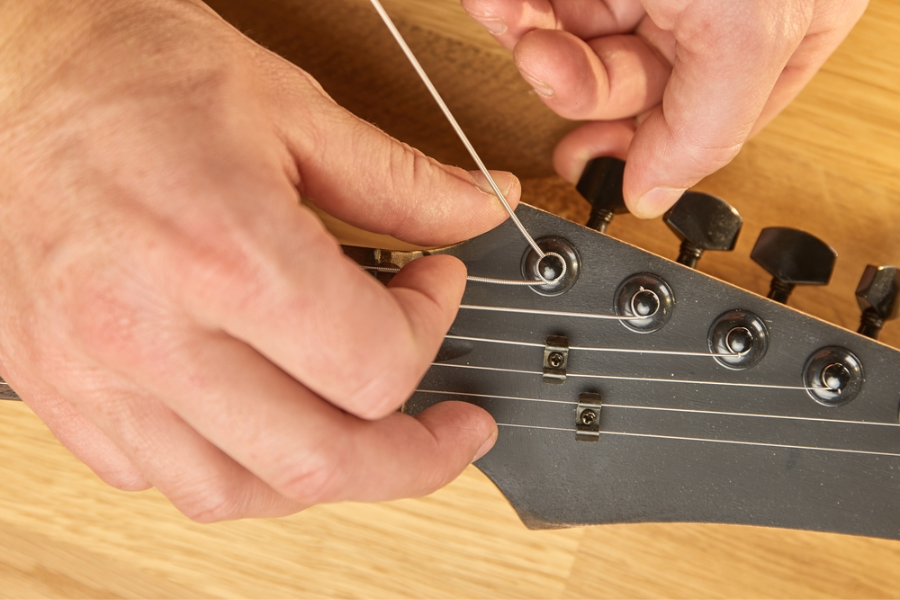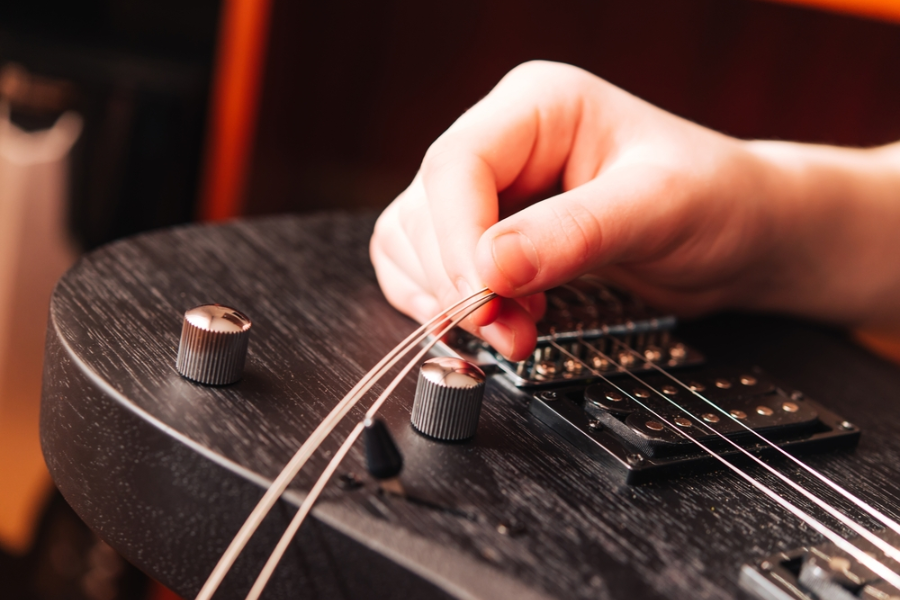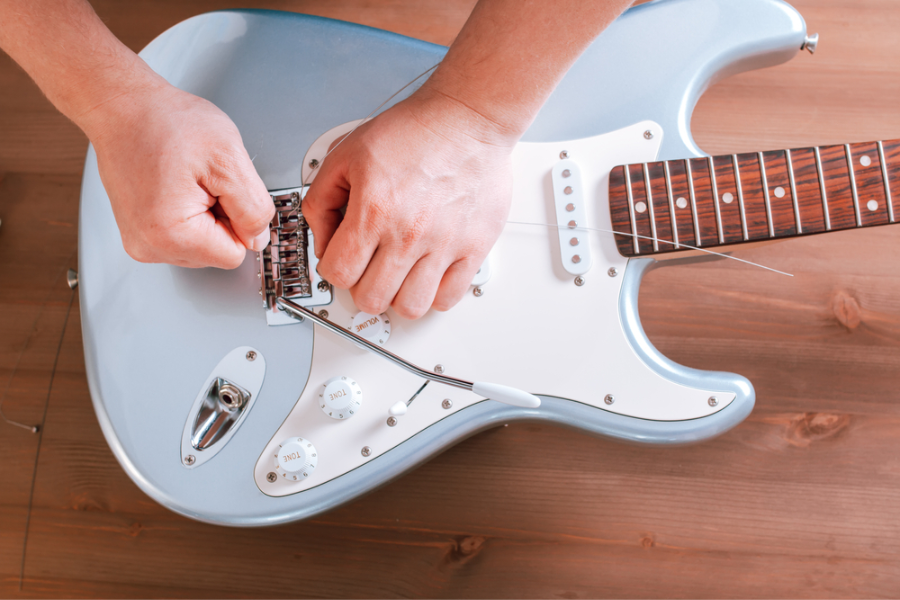Swapping out strings on your electric guitar, especially a Stratocaster, might seem a bit scary at first. Changing a guitar’s strings is probably one of the first guitar maintenance skills a guitarist learns. You might worry about breaking a string or not getting it quite right. But it’s something every guitar player goes through.
In this guide on how to change electric guitar strings, Stratocaster, you’re going to learn how to make your guitar sound amazing again. You’ll learn not just the “how” but also the “why” behind each step, giving you a deeper understanding of your instrument. Eguitarmania will take you through each step, from picking the right strings to match your musical style, to the actual string-changing process, in a way that’s easy to understand and follow.

Materials You’ll Need To Change Electric Guitar Strings Stratocaster
To get started, we will walk you through the essential tools and accessories you’ll need for the change.
List of tools and accessories for the job.
Here’s a breakdown of what you’ll need to ensure a successful string change on your Stratocaster:
- String Winder: This handy tool speeds up the winding and unwinding of strings on the tuning pegs. The D’Addario Pro-Winder is a popular choice, as it combines a bridge pin puller in one compact tool.
- String Cleaner: Products like Dunlop 65 String Conditioner can be applied to your new strings for extra longevity and playability.
- Tuner: The Snark SN-8 Super Tight All Instrument Tuner is highly accurate and easy to use, making it a favorite among guitarists.
Choosing the right strings for your style and guitar.
Here are some considerations to help you choose the best strings for your Stratocaster:
| Aspect | Options | Description | Ideal For |
| Gauge | Light (.009-.042) | Easier to play and bend, less tension on the neck. | Blues, Rock, Jazz |
| Medium (.010-.046) | Balanced tone and playability, slightly more tension. | Rock, Country, Pop | |
| Heavy (.011 and up) | Fuller sound, more volume and sustain, higher tension. | Metal, Hard Rock | |
| Material | Nickel-plated Steel | Bright and warm tone, versatile. | Most genres |
| Pure Nickel | Warmer, vintage sound. | Blues, Classic Rock | |
| Stainless Steel | Bright, punchy tone, highly durable and resistant to corrosion. | Players needing durability |
How To Change Electric Guitar Strings Stratocaster ?
It might sound hard to change the strings on a Stratocaster electric guitar, but if you know what to do and how to do it right, it’s easy and fun.

- Safely removing old strings.
Begin by gently loosening each string using a string winder, reducing the tension until the strings are slack. I always start by loosening the strings gradually. Once slack, use wire cutters to cut the strings near the sound hole. This prevents any sudden release of tension that could damage the guitar’s neck or body.
For a Stratocaster, strings are typically anchored at the bridge with small ball ends, which should come out easily once the string is slack.
- Cleaning and maintaining your guitar’s neck and body.
I recommend giving your instrument a good cleaning before stringing it up again. Use a soft, dry cloth to wipe down the neck and fretboard. Specialized fretboard cleaners can also be applied to condition the wood, especially if it’s rosewood or ebony.
Wipe the body with a soft cloth, paying special attention to any buildup near the bridge and pickups. For tougher grime, a slightly damp cloth can be used, followed by a dry one.
- Attaching New Strings: Threading and securing strings at the bridge.
It is common for Stratocasters to have a tremolo bridge. Be careful not to loosen the new string when you insert its ball end into the hole on the bridge block that’s stashed behind the instrument. Making sure the string is sitting correctly in its slot, gently draw it through the bridge saddle.
- Techniques for proper winding and tension on the Tuning Pegs.
Thread the string through the hole in the tuning peg, leaving enough slack to wind around the peg several times. A good rule of thumb is to leave slack approximately three fingers’ width.
Begin winding the string with the string winder, keeping tension on the string with your other hand. Wind from the inside out, ensuring that each coil is neatly stacked below the previous one. It prevents sliding and tuning instability by maintaining balanced tension.
- Adjusting action and intonation after string change.
After the strings are replaced, you might notice changes in the height of the strings and intonation. Check the intonation by comparing the pitch of each string when played open and at the 12th fret. If there is a discrepancy, Stratocasters with a tremolo bridge allow you to adjust the height of the bridge saddles using a small Allen wrench.

Troubleshooting Common Issues
String Buzzing
Cause: String buzzing often happens if the strings are too low, the neck is not properly adjusted (truss rod adjustment needed), or the frets are worn out.
Personal Insight: Ensure that you leave enough slack in the string to wind around the peg at least two to three times when changing strings. By experimenting with the action and getting comfortable with minor truss rod adjustments, I found a sweet spot that eliminated the buzz.
Tuning Instability
Cause: New strings might stretch and cause tuning issues, or the strings might not be properly wound around the tuning pegs.
Personal Insight: After changing strings, gently stretch each string by pulling it away from the fretboard, then retune. After a stressful practice when my guitar wouldn’t remain in tune, I began stretching each string during changes. This, together with properly winding strings around tuning pegs, greatly increased tuning stability.
FAQs
Can I change strings without professional help?
Absolutely! With some basic tools and helpful online videos or guides, you’ll be changing strings like a rock star. You’ll save money at the guitar shop and get a better knowledge of your guitar by practicing.
How often should I change my Stratocaster strings?
A good rule of thumb is to change your strings every 3 to 4 months if you play regularly. Changing your strings at least once a month, or more often if you perform live, can help your guitar music seem new.
What are the best strings for a stratocaster?
Ernie Ball Regular Slinkies (.010–.046) work for any song. You’ll sound clean and strong performing chords or solos with their guidance.
Designed for Stratocasters, Fender Super Bullets strings (.009 -.042) improve tone and sustain higher notes.
D’Addario EXL110-3D strings range from.010 to.046, giving your guitar a bright, unique tone.

Final Thoughts
Changing the strings on your Stratocaster guitar is a key skill. It’s like giving your guitar a little check-up to make sure it sounds its best. With some practice, you can do it yourself with no need for help from anyone else. Plus, you’ll feel even closer to your guitar, ready to play your best music.









